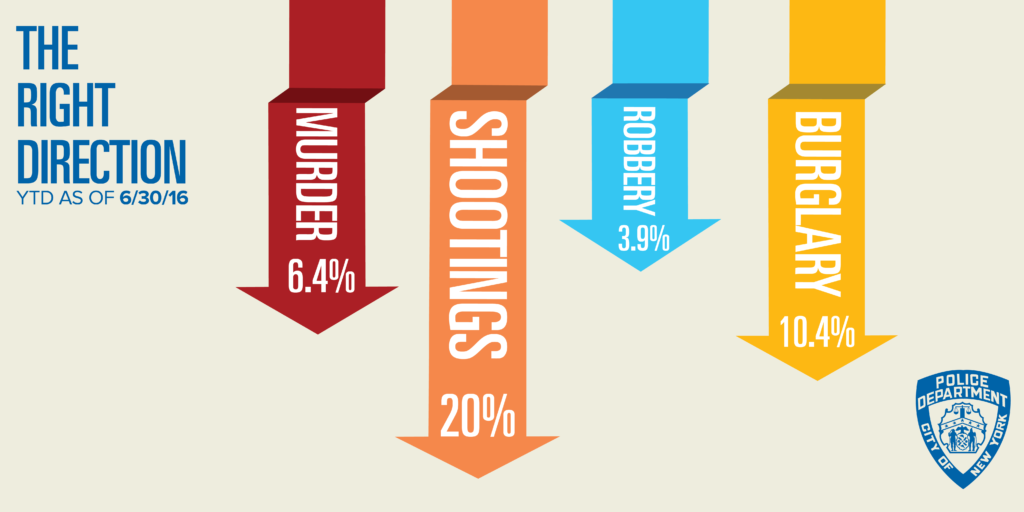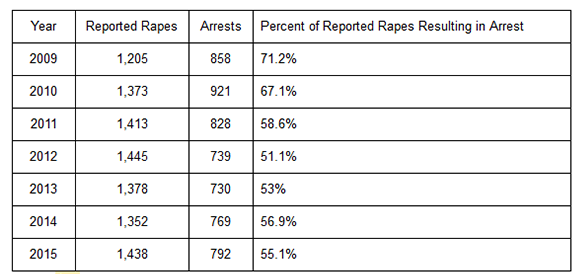
Mayor de Blasio at a press briefing (photo: Michael Appleton/Mayor's Office)
“You’re going to hear some numbers that are striking,” said Mayor Bill de Blasio as he began an August 4 press conference on the city’s latest crime statistics. “2016 saw the fewest shootings, the fewest robberies, the fewest burglaries, the fewest auto-thefts of any first-half of a year in a CompStat era. So, when you think about that, the lives of everyday New Yorkers are freer. They’re more peaceful. They’re less disrupted. And people have every reason to feel safer.”
Yet, there are some striking numbers that are less often heard during the mayor’s crime briefings, which have lately had a celebratory tone, like the city’s rising number of reported rapes, increasing reports of misdemeanor sexual assaults, and decline in the percentage of reported rapes that result in arrest.
While violent crimes like murder and shootings are largely declining in New York City, reports of another type of violent crime, rape, have increased over the past two years. Through the middle of August, according to NYPD statistics, there have been 717 shooting victims in the city, a 15.5 percent drop from the same point last year, and 931 reported rapes, a 7.4 percent increase from 2015.
Many in New York City are fixated on gun violence, and for good reason, but the consistent uptick in another violent act that can leave physical and psychological scars remains troubling and under-appreciated by many.
Rape, like all other felonies in New York City, has declined since the NYPD began keeping track of such crimes using CompStat more than two decades ago, yet the recent increase in reported rapes demands attention. It is unclear if that attention is being given, since discussion of rape is largely missing from the mayoral-NYPD press conferences and data from the NYPD shows that the percentage of reported rapes resulting in arrest dropped 16 percent from 2009 to 2015 (from 71 to 55 percent), while the number of reported rapes has increased 19.3 percent during that same time.
To celebrate the crime statistics for the first half of 2016, the NYPD created a six-page pamphlet, “Half Year Crime Report,” that indicates drops in murder, shootings, and overall arrests on the cover. Inside the handout, there are infographics about “precision policing” and “gang takedowns,” as well as a page labeled “The Right Direction,” showing downward arrows labeled “murder,” “shootings,” “robbery,” and “burglary.” There is no mention of the increase in reported rapes on that page or any of the others.

As of 2015, roughly half of reported rapes result in arrest, and even when arrests are made, charges are not always filed. Tracking the results of these reported rapes (prosecution, conviction, dismissal, etc.) is further obfuscated by the way in which both city and state authorities, from the NYPD and the District Attorneys to the State Division of Criminal Justice Services, keep records of rapes.
Reported rapes in the city declined between 2003 and 2009, dropping from 2,070 in 2003 to the city’s all time low of 1,205 in 2009. The number of reported rapes steadily increased in the three years that followed, with 1,373 in 2010; 1,420 in 2011; and 1,445 in 2012.
Reported rapes dipped slightly for two years (1,378 in 2013 and 1,352 in 2014), before rising once again, to 1,438, in 2015. This year, 2016, is on track to have an even greater number of reported rapes: through mid-August, there were 931 reported rapes, up from 867 this time last year, putting the city on pace to have 1,544 reported rapes by the end of 2016 (about 100 more than last year).
It is possible that the rising number of reported rapes is partially the result of more rapes being reported, rather than more rapes being committed, something which outgoing Police Commissioner Bill Bratton has dubbed the “Cosby Effect,” referring to Bill Cosby and the attention around all of his alleged victims coming forward, some after many years. Heightened awareness about sexual assault and improved social norms about reporting rape could be leading more victims, especially women, to come forward.
“With the rapes that were recorded in New York City this year, one out of four did not occur this year – and that’s fairly consistent with what we see in prior years,” Deputy Commissioner Dermot Shea said during a July press conference at which NYPD officials and Mayor de Blasio celebrated the half-year crime numbers. (At that press conference, Shea did note the increase in rape - “up 7.3 percent,” he said - but he did not discuss efforts to combat the uptick. At the August crime briefing for press Shea said “rape was up” and moved on.)
Of the 1,438 rapes reported in 2015, 235 occurred prior to that year, dating as far back at 1975.
Police departments across the country are reporting a similar trend, and the increase in reported rapes coincides with city and state efforts to encourage more victims of rape to come forward and report the crime.
In the past two years, the NYPD has created new agreements with local colleges to encourage immediate reporting of sexual assault, worked with hospital emergency rooms to encourage reporting, and distributed 48,000 cards and flyers throughout the city explaining sexual violence and encouraging people to report crimes to the Special Victims Division. In 2014, the Metropolitan Transit Authority created an online portal for sexual misconduct complaints, where victims may attach a photo and make an anonymous report.
“I think it would be logical to presume that if there’s an increase in acquaintance rapes being reported, it might in fact be an increase in reporting, because there has been so much focus on this issue of non-stranger rape in the past few years, especially on college campuses,” said Lisa Smith, former chief sex crimes prosecutor for the Brooklyn District Attorney’s office and professor at Brooklyn Law School. “I definitely think the publicity is encouraging women to report.”
Still, there are likely far more rapes occurring in New York City than are reported, given that nationally only about 34 percent of rapes result in a police report, according to the Department of Justice, with less than 2 percent of those reports resulting in the rapist’s incarceration. And while the city’s efforts to encourage more victims to come forward are praiseworthy, they should coincide with an increase in the number of rape cases that actually result in some semblance of justice for the victim, and with efforts to prevent such crimes from occurring in the first place.
For example, the NYPD could do more to let New Yorkers know where stranger rapes are occurring. Currently, CompStat 2.0 maps incidents of rape down to the nearest intersection, but does not distinguish which category of rape the crime falls under - stranger, acquaintance, or domestic. While the vast majority of rapes reported in the city are acquaintance or domestic (92 percent, according to the NYPD), rapes committed by strangers also rose from 2014 to 2015 (117 to 166).
Yet, “there is no easy way for a civilian to determine” where stranger rapes are frequently occurring, as New York Times writer Ginia Bellafante pointed out, such as in 2013, when a man raped four women in the span of a week, finding all of his victims along the B12 bus route between Crown Heights and Canarsie.
Reports of misdemeanor sex crimes, including forcible touching, public lewdness, and unlawful surveillance, have also spiked in recent years, particularly on the subways, where reports of such crimes have increased by 56.7 percent (431 crimes through May, 275 by the same time in 2015).
By mid-August 2014, there were 1,595 reported misdemeanor sex crimes in New York City. By the same time in 2015, that number rose to 1,887. This year through mid-August, there have been 2,096 reported misdemeanor sex crimes, an 11.1 percent increase from last year. Again, this increase could be due in part to efforts to encourage victims to report sex offenses, rather than an increase in the number of sex offenses occurring.
Ideally, more reports would lead to more arrests, more prosecutions, and more convictions - more justice for victims who are increasingly willing to put their faith in the system and go through with the onerous and emotionally taxing process of reporting the crime and all that follows. Data from the NYPD shows this is not the case.
 *Arrest data provided by NYPD Deputy Commissioner of Public Information
*Arrest data provided by NYPD Deputy Commissioner of Public Information
Even when arrests are made, charges are not necessarily filed. Best-selling memoirist Mary Karr recounted an instance of forcible touching on the streets of Manhattan for The New Yorker earlier this August, culminating in the arrest of a man she dubbed “the crotchgrabber.”
“Nobody ever called me to court, but the cops had cuffed him, dragged him out of the bus station, and booked him,” Karr wrote. “A woman should be able to count on follow-through from the justice system—they’d eventually fail to charge him.”
The picture is incomplete without data on outcomes of these arrests and reports, yet the fact that only half of reported rapes result in arrest, and the number of arrests is declining while the number of reported rapes is increasing is cause for concern.
Because of the way New York City’s Police Department and District Attorney offices keep track of these crimes, it is nearly impossible to determine whether the city’s efforts to encourage more rape victims to report crimes to the police are actually resulting in more justice for the victims, or, ultimately, more trauma, forcing victims relive the event multiple times while relaying their stories to the police, with nothing to show for it but a police report and wasted time.
The NYPD does not keep track of prosecutions or convictions, while the District Attorney offices do not keep numbers of reports or arrests. This disconnect makes it difficult to link the number of reported rapes to the number of prosecutions and convictions that result from those reported rapes. Tracking the outcomes is further complicated by the fact that each of the five District Attorney offices may not maintain records in the same way.
Instead, the State Division of Criminal Justice Services keeps more consistent records of arrests and dispositions across all five boroughs. Yet, data compiled by DCJS presents its own challenge: not only is DCJS unable to link the number of reported rapes to the number of rape arrests made (rather, its data on the outcomes of those arrests begin with the arrest, not with the report), the number of rapes the NYPD reports to DCJS (2,244 in 2015) is far greater than the number of rapes the NYPD reports internally. This is because the NYPD must use the FBI’s definition of rape when reporting the number of rapes that occurred in any given year to the state, which is broader than the NYPD’s definition.
“Rape is a crime of opportunity, so it’s a bit harder to prevent,” NYPD Deputy Commissioner of Public Information Lieutenant John Grimpel told Gotham Gazette in a phone interview. “Once we are made aware of a crime, we investigate all rapes the same. If a violent crime happened to you, we want you to come forward.”
Those who commit sexual violence are less likely to go to jail or prison than other criminals, like those who commit robbery or assault. The vast majority of reported rapes in New York City are committed by someone the victim knows, yet, as NYPD Deputy Commissioner Shea said in July, “the unique nature of these cases at times makes it difficult as we move through the criminal justice system.”
While stranger rapes constitute a small percent of the city’s reported rapes, they typically command greater police and media attention, and “there is very good evidence that those cases end up in prosecution or conviction most of the time,” said Smith, formerly of the Brooklyn DA office, now at Brooklyn Law School.
Getting justice for the victims of domestic or acquaintance rape is generally a murkier process, though in the past few years, stories of acquaintance rape - from Bill Cosby to college campuses - have begun to be taken more seriously.
Governor Andrew Cuomo has put some focus on college campus sexual assault in New York, signing legislation requiring all colleges and universities to adopt new measures to prevent and respond to rape in July 2015. In New York City, the Manhattan District Attorney’s Sex Crimes Unit regularly conducts trainings for representatives from local colleges and universities to help individuals better identify and encourage reporting of sexual assault. DA Cy Vance has also dedicated money from his office’s settlements to reducing the backlog of rape kits across the country.
Campus rape in New York City made widespread headlines in 2014 when then-Columbia student Emma Sulkowicz began carrying a mattress around campus to protest the fact that her accused rapist remained on campus. Across the country, shockingly light sentences handed down to convicted rapists in cases of acquaintance rape on college campuses have garnered national attention in recent months. Brock Turner, the Stanford student convicted of three counts of sexual assault, was sentenced to six months in jail in June (he faced a maximum of 14 years in state prison). On August 10, a judge ruled that Austin Wilkerson, a University of Colorado student convicted of sexually assaulting an intoxicated woman, will not have to serve a prison sentence, and instead sentenced him to two years work-release and 20 years probation.
“If more than a quarter of people in this community were killed by a drunk driver, or assaulted or menaced during an invasion of their home, the community would call for a stronger message than a sentence of probation with no punitive sanction to effectuate respect for the law, the deterrence of crime, and the protection of the public,” District Attorney Stanley Garnett wrote in a victim memo to the court.
“Sexual assault should be no different. Murderers go to prison. Armed robbers go to prison. Rapists go to prison. This is what justice requires,” Garnett wrote.
Ultimately, the city should also invest more in efforts to prevent sexually violent crimes from happening in the first place. In order to truly reduce the number of sexual assaults that take place, advocates and the national Center for Disease Control and Prevention alike say “primary prevention” or prevention education is the most effective method.
“So much of prevention for non-stranger rapes has to do with educating young people about consent in middle school and in high school,” Smith said. “There are many different institutions that need to get involved in that, and law enforcement is only one spoke on that wheel.”
Last year, California became the first state in the nation to mandate lessons on sexual violence prevention and affirmative consent in high schools. Yet in New York City, educational programs “shown to prevent sexual violence perpetration,” according to the CDC, are not mandated, but rather, are left up to the discretion of the principal in middle and high schools.
The de Blasio administration and the City Council have demonstrated willingness to fund programs to prevent violence and protect New Yorkers time and again, from investing $12.7 million in gun violence prevention programs in 2014 to allocating $115 million in new capital funds earlier this year to expand the city’s Vision Zero program to reduce traffic fatalities.
Judging by the numbers, the city’s efforts seem to be working. Shooting victims are down 15.6 percent over the past two years. There were 231 traffic fatalities in 2015, 66 fewer than in 2013, the year before Vision Zero began. There were more reported rapes in the first three months of 2016 alone, 310, than traffic fatalities in all of 2015.
“Obviously, we are deeply concerned about the safety of the women in this city, and again, we don’t like some of these trends we see and we want to combat them,” Mayor de Blasio said in response to a question about the rising rape numbers during a January 12 press conference. “We take this very, very seriously and it’s our responsibility, period.”
The mayor’s office declined to comment further for this story, deferring to the NYPD.
***
by Meg O'Connor, Gotham Gazette
@megoconnor13 @GothamGazette




